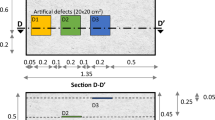Abstract
Radar processors may suffer from performance loss when the heavy clutter is not sufficiently suppressed in a heterogeneous environment. In order to achieve the clutter suppression and further improve the detection performance, the clutter nulling method is widely addressed in radar systems, especially for the low-rank clutter in space–time adaptive processing, where the rank of the clutter covariance matrix is smaller than the length of test data vector. For the ubiquitous clutter-plus-noise environment in practice, where it is assumed as the superposition of the white Gaussian noise and the low-rank compound-Gaussian clutter without the accurately prior information of the texture, this paper develops a clutter nulling approach, whose kernel and emphasis are to obtain the maximum-likelihood estimation of the orthonormal basis vectors of the clutter subspace. Precisely in processing, the proposed clutter nulling method is mainly derived with the application of the Lagrange multiplier method and adaptively implemented using iteration method with the training data. Finally, the results on numerical data validate the advantages of the proposed nulling approach, in comparison with the existing method.






Similar content being viewed by others
References
V. Anastassopoulous, G.A. Lampropoulos, A. Drosopoulos, M. Rey, High resolution radar clutter statistics. IEEE Trans. Aerosp. Electron. Syst. 35(1), 43–60 (1999)
N. Bon, A. Khenchaf, R. Garello, GLRT subspace detection for range and Doppler distributed targets. IEEE Trans. Aerosp. Electron. Syst. 44(2), 678–696 (2008)
M. Bouvet, G. Bienvenu, High Resolution Methods in Underwater Acoustics (Springer, New York, 1991)
L. E. Brennan, F. M. Staudaher, Subclutter visibility demonstration. Adaptive Sensors, Tech. Rep., RL-TR-92-21 (1992)
J. Carretero-Moya, J. Gismero-Menoyo, A. Asensio-L\(\acute{o}\)pez, A. Asensio-L\(\acute{o}\)pez, \(\acute{A}\) Blanco-del-Campo, Small-target detection in high-resolution heterogeneous sea-clutter: an empirical analysis. IEEE Trans. Aerosp. Electron. Syst. 47(3), 1880–1898 (2011)
J. Carretero-Moya, J. Gismero-Menoyo, \(\acute{A}\) Blanco-del-Campo, A. Asensio-L\(\acute{o}\)pez, Statistical analysis of a high-Resolution sea-clutter database. IEEE Trans. Geosci. Remote Sens. 48(4), 2024–2037 (2010)
G.L. Cui, L.J. Kong, X.B. Yang, Performance analysis of colocated MIMO radars with randomly distributed arrays in compound-Gaussian clutter. Circuits Syst. Signal Process. 31(4), 1407–1422 (2012)
R.J. Fogler, L.D. Hostetler, D.R. Hush, SAR clutter suppression using probability density skewness. IEEE Trans. Aerosp. Electron. Syst. 30(2), 621–625 (1994)
C.H. Gierull, Ground moving target parameter estimation for two-channel SAR. IEE Proc.-Radar Sonar Navig. 153(3), 224–233 (2006)
F. Gini, A. Farina, M. Greco, Selected list of references on radar signal processing. IEEE Trans. Aerosp. Electron. Syst. 37(1), 329–359 (2001)
F. Gini, A. Farina, M. Montanari, Vector subspace detection in compound-Gaussian clutter part II: performance analysis. IEEE Trans. Aerosp. Electron. Syst. 38(4), 1312–1323 (2002)
G. Ginolhac, P. Forster, F. Pascal, J. Ovarlez, Derivation of the bias of the normalized sample covariance matrix in a heterogeneous noise with application to low rank STAP filter. IEEE Trans. Signal Process. 60(1), 514–518 (2012)
M.V. Greco, F. Gini, M. Rangaswamy, Statistical analysis of measured polarimetric clutter data at different range resolutions. Proc. Inst. Elect. Eng. Radar Sonar Navig. 153(6), 473–481 (2006)
A. Haimovich, Asymptotic distribution of the conditional signal-to-noise ratio in an eigenanalysis-based adaptive array. IEEE Trans. Aerosp. Electron. Syst. 33(3), 988–997 (1997)
C. Hao, J. Yang, X. Ma, C. Hou, D. Orlando, Adaptive detection of distributed targets with orthogonal rejection. IET Radar Sonar Navig. 6(6), 483–493 (2012)
S. Kraut, L.L. Scharf, L. McWhorter, Adaptive subspace detectors. IEEE Trans. Signal Process. 49(1), 1–16 (2001)
Y. Liang, S. Pei-lin, Y. Lei, H. Ning, T. Jun, Modeling of compound-Gaussian sea clutter based on an inverse Gaussian distribution. J. Radars. 2(4), 461–465 (2013)
E. Ollila, D.E. Tyler, V. Koivunen, H.V. Poor, Compound-Gaussian clutter modeling with an inverse Gaussian texture distribution. IEEE Signal Process. Lett. 19(12), 876–879 (2012)
S. Panagopoulos, J.J. Soraghan, Small-target detection in sea clutter. IEEE Trans. Geosci. Remote Sens. 42(7), 1355–1361 (2004)
R.S. Raghavan, Statistical interpretation of a data adaptive clutter subspace estimation algorithm. IEEE Trans. Aerosp. Electron. Syst. 48(2), 1370–1384 (2012)
M. Rangaswamy, F.C. Lin, K.R. Gerlach, Robust adaptive signal processing methods for heterogeneous radar clutter scenarios. Signal Process. 84, 1653–1665 (2004)
J. Saebboe, D.T. Gjessing, Nonlinear and linear combination of multi-frequency signals for radar target classification; verification of basic relations. IEE Proc.-Radar Sonar Navig. 153(4), 352–360 (2006)
K.J. Sangston, F. Gini, M.S. Greco, Coherent radar target detection in heavy-tailed compound-Gaussian clutter. IEEE Trans. Aerosp. Electron. Syst. 48(1), 64–77 (2012)
M. Souden, J. Benesty, S. Affes, A Study of the LCMV and MVDR noise reduction filters. IEEE Trans. Signal Process. 58(9), 4925–4935 (2010)
Acknowledgments
The work is sponsored by the National Natural Science Foundation of China (61201276, 61178068 and 61301266), Fundamental Research Funds of Central Universities (ZYGX2012Z001), and Program for New Century Excellent Talents in University (A1098524023901001063).
Author information
Authors and Affiliations
Corresponding author
Rights and permissions
About this article
Cite this article
Chen, S., Kong, L. & Yang, J. Adaptive Clutter Nulling Approach for Heterogeneous Environments. Circuits Syst Signal Process 34, 987–1000 (2015). https://doi.org/10.1007/s00034-014-9874-6
Received:
Revised:
Accepted:
Published:
Issue Date:
DOI: https://doi.org/10.1007/s00034-014-9874-6




